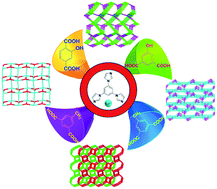Four new Cd(II) frameworks [Cd(tib)(p-BDC-OH)]·H2O (1), [Cd(tib)(m-BDC-OH)]·3H2O (2), [Cd(tib)(m-BDC-CH3)]·3H2O (3) and [Cd(tib)(m-BDC-CH3)]·11H2O (4) (tib = 1,3,5-tris(1-imidazolyl)benzene, p-H2BDC-R = 2-R-1,4-benzenedicarboxylic acid, m-H2BDC-R = 5-R-1,3-benzenedicarboxylic acid, R = OH or CH3) have been successfully synthesized under solvothermal conditions. 1 is a 3D framework with a Point symbol of {810}{83} constructed from Cd-tib 3D net and Cd-p-BDC-OH 1D helical chain. 2 and 3 possess different 3D structures with the same topology of {4·62}{4·66·83} built from Cd-tib 2D networks and Cd-m-BDC-R 1D linear chains, while 4 is a 2D network with {42·67·8}{42·6} topology based on Cd-tib and Cd-m-BDC-CH3 1D chains. The results show that the dicarboxylate ligands and reaction medium play important role in determining the structures of MOFs. Moreover, ferroelectric and photoluminescence properties of the complexes were studied.

